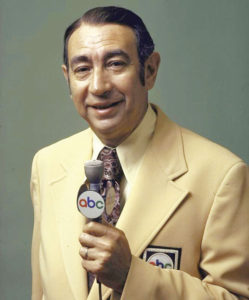America’s Sport
9/4/2019How football has replaced baseball as our sport of choice
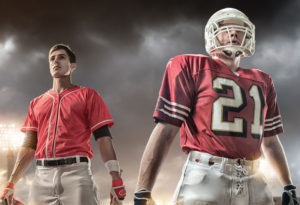 In 1919, two years before the first baseball radio broadcast, the New York Times reported that all records for crowds at Times Square had been “shattered” by the horde that rubbed shoulders for blocks to watch a scoreboard reenactment of the first game of that year’s World Series matching the Chicago White Sox and the Cincinnati Reds. Crowd estimations were not an exact science 100 years ago, and they ranged from 17,000 to 90,000 on that occasion, when New York City had seven newspapers. Photos suggest that the high number is closer to the truth.
In 1919, two years before the first baseball radio broadcast, the New York Times reported that all records for crowds at Times Square had been “shattered” by the horde that rubbed shoulders for blocks to watch a scoreboard reenactment of the first game of that year’s World Series matching the Chicago White Sox and the Cincinnati Reds. Crowd estimations were not an exact science 100 years ago, and they ranged from 17,000 to 90,000 on that occasion, when New York City had seven newspapers. Photos suggest that the high number is closer to the truth.
In 2016, the seventh game of the World Series between the Chicago Cubs and the Cleveland Indians drew the largest television audience ever to watch a baseball game — 40 million. However, that same year, 115 million fans watched the Super Bowl game between the Carolina Panthers and the Denver Broncos.
Such record audiences suggest many things about sports and America. Most obviously, football has conquered the hearts and minds — and preferred sports apparel purchases — of the country. Baseball, also known as “America’s pasttime,” was king from the late 19th century through the 1960s. What happened in the country that changed our favorite sport?
A media revolution
One hundred years ago, almost all news came from newspapers. Radio was just getting started, but it would challenge the papers through World War II. Baseball is a quotidian game, 162 games now plus playoffs. A player’s success is measured in accumulated statistics — runs, hits, runs batted in, home runs, on-base percentage, earned run averages, strikeouts and, of
course, wins and losses. That all is best followed in the papers, many of which barely cover this former strength anymore because the Internet can do it better.
Radio was the best way to follow a team’s everyday games through the 1960s. Before 1969, regional television stations did not cover road games. So, fans were left to radio, what the late baseball commissioner and poet Angelo Bartlett Giamatti called “the green fields of the mind, where what the old poet called Mutability does not so quickly come.” Giamatti’s ode to
baseball is compared to Dylan Thomas’ “Fern Hill.” By placing the real work of following his favorite game on the radio, Giamatti’s masterpiece lacks the doom and pessimism of Thomas’ similar poetic nostalgia.
That’s an important point in the history of the intermingled destinies of media and sports in America. Baseball is a game of spring, when everything is new and hopeful. It’s also a sport of nostalgia. Giamatti wrote that, through radio, stars or yesteryear remain young and virtually immortal in the mind’s eye of the beholder.
Television, by contrast, sees all and reveals all, usually without the makeup and soft lighting of studio news or soap operas. Television became a real thing with post WWII prosperity. It was a kinder, gentler time than any that has come since. Boomers still recall “Mickey Mouse Club,” “Father Knows Best” and “The Ed Sullivan Show” as significant parts of their childhoods. Slowly, live television, with its transparency, became the vehicle that made us familiar with the floodwaters of social change that roiled the country. The Civil Rights Museum in Little Rock gives half its space to demonstrate this. The Central High School desegregation there was the first television mega event. The violence, the hatred and the bravery were all narrated nightly by Walter Cronkite and Chet Huntley. The reaction changed minds and sped up the Civil Rights movement by an exponential factor. William Faulkner had been writing about similar injustices for a quarter century without impressing America as much as one telecast from Central High School did.
Violence was felt viscerally on television. The Vietnam War was an epic TV event at the time when television was discovering that it was all about big, once a week, once a year type events. Radio and the newspapers were constructed for daily consumption, with no time for hype. Television was born to love football, which grew quickly into America’s new favorite sport. The creation of the Super Bowl in 1967 and of “Monday Night Football” in 1970 were brilliant strategic moves that cemented football’s dominance over baseball. Both were made for TV because they were respectively annual and hebdomadal (a word that Howard Cosell introduced to many Americans on
“Monday Night Football”) events. Baseball remained stuck in the newspaper and radio age.
“Monday Night Football” became an American cultural phenomenon. It is still the only prime time television show to lead all shows in ratings for eight years. “American Idol” is second with seven, and no other show has more than three seasons on top. In the 1970s, people in California would rush home from work for the 5 p.m. kickoffs. It was the first sports event ever to make announcers (Cosell, Frank Gifford and Dandy Don Meredith) into national superstars. And it grew the ratings of regional Sunday games. It was “game over.” Football and television won.
Gambling’s impact
America has also become a gambling nation. Two local bookies told me that only 2 to 3 percent as much action is placed on baseball compared to football. Drake law professor Keith Miller, a national gaming law expert, told CITYTVIEW that football’s share of action is apt to grow more when smart phones can handle proposition betting in Iowa late this year. That includes betting on things like coin tosses, first player to score and first kicker to miss. Phones are obviously smarter than the gamblers now.
The San Diego Union-Tribune sports columnist at large Bryce Miller, formerly Des Moines Register sports editor, sees football’s triumph this way. “I think it’s kind of a smoke and mirrors thing. Yes, the ratings dominate any other sport, so it creates the impression that’s the case. But what’s really behind it is sports gambling, in all forms. There’s more legalized gambling, and even fantasy teams are gambling, since it all revolves around money. Super smart marketing, since following players is like reality TV for moms, sisters, non-sports folk who could not care less about the actual games.
People watch their bets, and they watch their players. Would some watch without all that? Sure. And it still might dominate. But no sport does gambling/fantasy sports better than football. I barely watch the NFL but love college football. So I’m more inclined to lean that way.”
Baseball vs. football
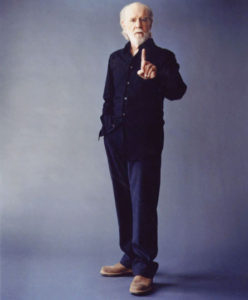
“…And finally, the objectives of the two games are completely different: In football, the object is for the quarterback, also known as the field general, to be on target with his aerial assault, riddling the defense by hitting his receivers with deadly accuracy in spite of the blitz, even if he has to use shotgun. With short bullet passes and long bombs, he marches his troops into enemy territory, balancing this aerial assault with a sustained ground attack that punches holes in the forward wall of the enemy’s defensive line. In baseball the object is to go home! And to be safe! I hope I’ll be safe at home!” — George Carlin
About the same time that “Monday Night Football” began, comedian George Carlin was fighting baseball’s last stand. In perhaps his most famous routine, he appealed to the hippie nation of nonviolence, antiwar protests and peace signs by reminding us of the differences as he saw them:
“Baseball begins in the spring, the season of new life. Football begins in the fall, when everything’s dying. In football you wear a helmet. In baseball you wear a cap. Football is concerned with downs — what down is it? Baseball is concerned with ups — who’s up? In football, you receive a penalty. In football the specialist comes in to kick. In baseball the specialist comes in to relieve somebody.
“Football has hitting, clipping, spearing, piling on, personal fouls, late hitting and unnecessary roughness. Baseball has the sacrifice. Football is played in any kind of weather: rain, snow, sleet, hail, fog. In baseball, if it rains, we don’t go out to play. Baseball has the seventh inning stretch. Football has the 2 minute warning. Baseball has no time limit: we don’t know when it’s
going to end — might have extra innings. Football is rigidly timed, and it will end even if we’ve got to go to sudden death.
“In baseball, during the game, in the stands, there’s kind of a picnic feeling; emotions may run high or low, but there’s not too much unpleasantness. In football, during the game in the stands, you can be sure that at least 27 times you’re capable of taking the life of a fellow human being. And finally, the objectives of the two games are completely different: In football, the
object is for the quarterback, also known as the field general, to be on target with his aerial assault, riddling the defense by hitting his receivers with deadly accuracy in spite of the blitz, even if he has to use shotgun. With short bullet passes and long bombs, he marches his troops into enemy territory, balancing this aerial assault with a sustained ground attack that punches holes in the forward wall of the enemy’s defensive line. In baseball the object is to go home! And to be safe! I hope I’ll be safe at home!”
You can add to Carlin’s list that baseball is a 19th century pastoral game, and football is a 20th-century technological overload of information. Baseball is played on a diamond, in a park like “The Friendly Confines.” Football is played on a gridiron, in a stadium, sometimes called something like Soldier Field or War Memorial. In most sports, you score points or goals; in baseball you score runs.
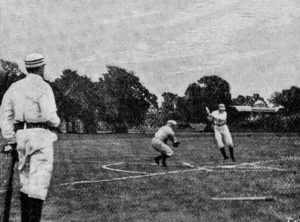
Baseball is a game of spring, when everything is new and hopeful. It’s also a sport of nostalgia. Photo by GettyPay
Carlin was too late to save his favorite pastime from humiliation to the gridiron. America was becoming a much more violent place, and football appealed to the same people who turned to video games, Charles Bronson movies, heavy metal and gangster rap.
Some of Carlin’s points are far from mainstream now. The NFL worked to fit games tightly within a three-hour framework. Baseball and basketball, and even NCAA football, can go on forever. As people’s lives became more complicated with multiple activities, the dependable timeframe helped football. As America became more conscious of racism and sexism, football seemed to be out of that discussion. Women don’t play, nor seemingly want to. Blacks and whites star with remarkable evenness. You don’t watch games for the coaches.
America is debatably more chauvinistic than it used to be, at least in peace times. Chants of “USA, USA” can be embarrassing to the Olympic spirit. The NFL has the fewest foreign born players of any major sport at 3.5 percent. Baseball has 27.5 percent, hockey’s NHL has 71.3 percent foreign born players and the NBA 24 percent.
A coach’s perspective
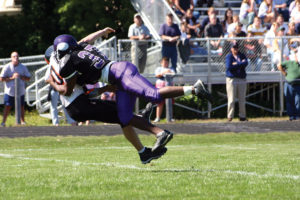
Television was born to love football, which grew quickly into America’s new favorite sport. Photo by Getty
Tom Gruening played football at Roosevelt High School and in college before becoming head football coach at his alma mater. He has a take on football rather opposite to Carlin’s.
“No other sport creates the kind of camaraderie as football. I am still close to my old teammates. Playing football is more like serving in the armed forces; you bond for life. I think that is because football is a more emotional sport, and emotions stay with us longer than tactics, strategy and such things. I still remember running through doors, literally, after a halftime speech at Roosevelt,” he said.
I recall my high school coaches telling us “Boys, this is probably as close as you will ever get to war.” That was early in the Vietnam War but still rather farfetched and dubious. Fewer youths are playing football today. Concerns about injuries — particularly to heads and knees — steroids, pressure to commit to a single sport, disgust with player protests against police violence, and sex abuse have been turning parents off. Gruening thinks football survives these things because it’s been more violent than other games, at least since the end of the gladiatorial era and the Mayan death
ball game.
Some of the glamour of football has been diminished by the growth of female sports. Girls care more about their own games now than boys’ games, and cheerleaders can be rare these days. To my mind, the most interesting of Iowa high school championships is now the combined state track meet, which totally packs Drake Stadium as boys and girls alternate events.
Like all the great empires of antiquity, the NFL is subject to frequent analysis. Unlike Tiberius Caesar or Kublai Khan, however, Roger Goodell, Jerry Jones and the rest of the league’s power structure discern the relative health of their kingdom via weekly television ratings.
But what is the next technology of media? Something new could change the way Americans perceive and support various sports. So far it looks like football is doing better than others with streaming and other Internet media. While these reports are only slightly more elucidating than analyzing the entrails of bats, the bat guts of the NFL priests are still looking better than the auguries of other sports. ♦





